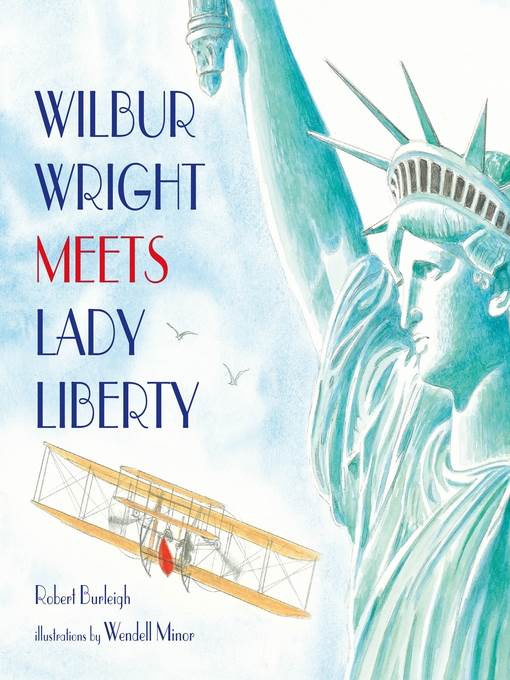
Wilbur Wright Meets Lady Liberty
کتاب های مرتبط
- اطلاعات
- نقد و بررسی
- دیدگاه کاربران
نقد و بررسی

January 25, 2021
In this measured telling, previous collaborators Burleigh and Minor recount the first public flying exhibition of Wilbur and Orville Wright’s airplane, during a 1909 technology showcase in New York City. As the pages turn, Wilbur Wright straps a red canoe to the bottom of the Wright Flyer before piloting it over New York Harbor, around the Statue of Liberty, and over the Lusitania. Omniscient narration juxtaposes Wilbur Wright’s measured, methodical actions and observations (“His feet brace... His grip tightens”) with mounting excitement: “The Flyer angles upward into the air: Ten feet. Thirty feet. Fifty!” Though enthusiastic commentary flanks the moment-by-moment account, the description of Wilbur’s skilled, unruffled performance creates an understated tone. Realistic gouache watercolors offer varying perspectives that give scale to both statue and plane. Bookending the story is a second one about a boy who was inspired on that day; intermittent spreads depict sepia-toned portraits of Juan Trippe—who would later found Pan American Airways—alongside imagined spectator comments. Back matter includes creators’ notes, a brief recap of the Wright brothers’ endeavors, and other information about the exhibition. Ages 5–9.

January 15, 2021
Two American icons "met" high above New York Harbor one morning in 1909. On Sept. 29, 1909, Wilbur Wright, co-inventor of the airplane, piloted his Wright Flyer around the Statue of Liberty for six and a half minutes. Awestruck spectators, most of whom had never witnessed a flight, included journalists, photographers, and 10-year-old Juan Trippe and his parents. Adding to the spectacle were numerous boats in the harbor, including the Lusitania. Though confident, Wright nevertheless attached a red canoe to the bottom of his plane--just in case--before rising to circle the pale-green Liberty and make the first-ever flight over New York City. Afterward, the crowds roared. Burleigh relates this exciting, little-known event from two perspectives. Children read/hear the voices of Juan and his parents (set in italicized type), making their presence immediate. This punctuates the dramatic third-person narration, expressed in a terse present tense that adds suspense. Minor's splendid illustrations offer numerous grand perspectives and are rendered in lush watercolors, providing appropriate airiness and lending nostalgia; the scenes depicting Juan and his parents are sepia toned. Wright and the Trippes appear White. Front endpapers reproduce a newspaper account of the event; the backmatter contains excellent additional information, including a map. (This book was reviewed digitally with 10-by-20-inch double-page spreads viewed at 83.8% of actual size.) This high-flying book will send readers' imaginations soaring. (author's note, illustrator's note, bibliography, source notes) (Informational picture book. 6-9)
COPYRIGHT(2021) Kirkus Reviews, ALL RIGHTS RESERVED.

Starred review from May 1, 2021
Gr 1-5-This narrative nonfiction book tells the story of September 29, 1909, when Wilbur Wright exhibited his technological marvel, a flying machine. Burleigh's compelling narrative allows readers to feel the excitement of the crowd and Wright's anxiety over the machine working properly and fears for his own safety. The sensory details that Burleigh adds lend a personal connection to the event. The beautiful gouache watercolors on double-page spreads allow readers to appreciate the scale of the plane and the Statue of Liberty as well as the skyline of the city and the boats in the New York harbor. Even the end papers of the book add to the story-the front end papers are a reproduction of a newspaper account of the event and the back are a map of the flight path. The author's notes also provide some surprising information. One of the people in the crowd that day, shown in the book in sepia-toned pages and panels, was 10-year-old Juan Trippe, who was so inspired by the flight that he eventually became an aviator himself and went on to found Pan American Airways. Readers of all ages will enjoy this very well-told story. VERDICT This is a must-have for any collection that has elementary school aged patrons. It would be an excellent book for teaching lessons on perseverance, inventions, American history, narrative nonfiction, or biographies.-Debbie Tanner, S.D. Spady Montessori Elem., FL
Copyright 2021 School Library Journal, LLC Used with permission.

























دیدگاه کاربران